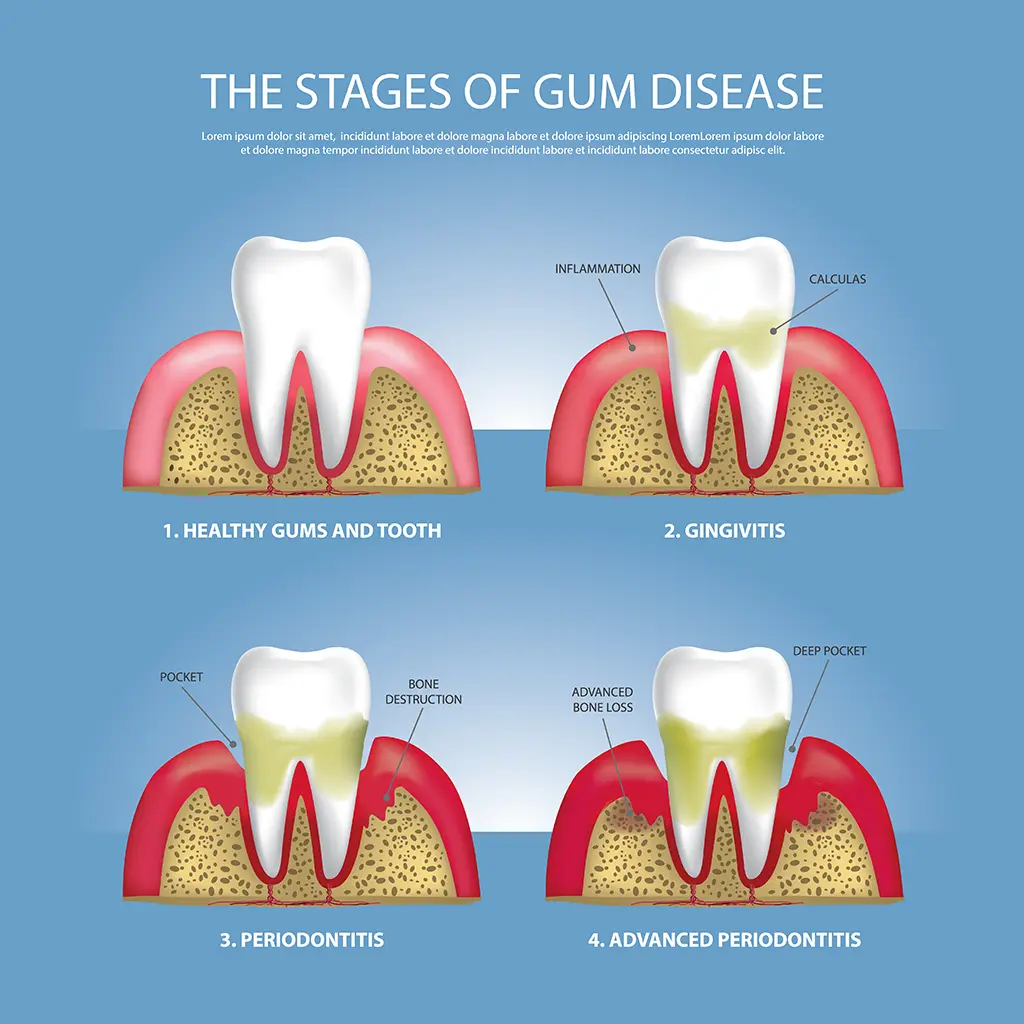Gum disease, also known as periodontal disease, is a common but serious condition that affects the gums and bones supporting the teeth. Without proper care, it can lead to tooth loss and other significant health problems. This article will provide an in-depth understanding of gum disease, its causes, symptoms, and the stages of gum disease, as well as how to prevent and manage it. Whether you’re experiencing early signs of gum disease or seeking ways to maintain healthy gums, Big Sky Family Dental is here to guide you through every step.
What is Gum Disease?
Gum disease is an infection of the tissues that hold your teeth in place. It is typically caused by poor oral hygiene that allows plaque—a sticky film of bacteria—to build up on the teeth and harden. In its early stage, gum disease is known as gingivitis. If left untreated, gingivitis can advance to periodontitis, a more severe form of gum disease that can damage the soft tissue and bone that support the teeth.
Causes of Gum Disease
The primary cause of gum disease is plaque, but several factors can increase your risk, including:
- Poor Oral Hygiene: Inadequate brushing and flossing can lead to plaque buildup.
- Smoking: Tobacco use is a significant risk factor for gum disease.
- Hormonal Changes: Such as those occurring during pregnancy, menopause, or menstruation.
- Medical Conditions: Conditions like diabetes can affect the body’s ability to fight infection.
- Medications: Certain medications can reduce saliva flow, which protects the gums and teeth.
- Genetics: Some people are more prone to severe gum disease due to genetic factors.
Stages of Gum Disease
Gum disease progresses through several stages, each with increasing severity.
1. Gingivitis
Gingivitis is the earliest stage of gum disease, characterized by inflammation of the gums. Common symptoms include:
- Red, swollen gums
- Bleeding gums, especially when brushing or flossing
- Bad breath
- Tender gums
2. Early Periodontitis
When gingivitis progresses, it turns into early periodontitis. The infection spreads below the gumline and begins to damage the bone and connective tissues. Symptoms include:
- Receding gums
- Formation of pockets between the teeth and gums
- Slight bone loss
- Increased bleeding
3. Moderate to Advanced Periodontitis
In the more advanced stages, the damage becomes more severe. Symptoms include:
- Deepening of the pockets between teeth and gums
- Significant bone loss
- Loose teeth
- Pus between teeth and gums
- Persistent bad breath
- Painful chewing

Preventing Gum Disease
Preventing gum disease is primarily about maintaining good oral hygiene and healthy lifestyle choices. Here are some effective strategies to prevent gum disease:
Practice Good Oral Hygiene
- Brush Regularly: Brush your teeth at least twice a day using fluoride toothpaste. Ensure you brush for at least two minutes each time.
- Floss Daily: Flossing removes plaque and food particles from between the teeth and under the gumline where a toothbrush can’t reach.
- Use Mouthwash: An antiseptic mouthwash can help reduce bacteria and plaque in the mouth.
Regular Dental Check-ups
Regular visits to Big Sky Family Dental are crucial for maintaining oral health. Professional cleanings remove tartar that brushing and flossing can’t eliminate. Your dentist can also identify early signs of gum disease and provide appropriate treatment.
Healthy Diet
A balanced diet rich in vitamins and minerals supports overall oral health. Limit sugary and acidic foods and drinks, which can contribute to plaque formation. Foods rich in vitamin C and calcium are particularly beneficial for gum health.
Avoid Tobacco Products
Smoking and using other tobacco products significantly increase your risk of gum disease. Quitting tobacco can improve your oral health and overall well-being.
Manage Health Conditions
Conditions like diabetes can increase your risk of gum disease. Managing these conditions through proper medical care and healthy lifestyle choices can help reduce your risk.
Managing Gum Disease
If you already have gum disease, it’s crucial to take steps to manage it and prevent further progression. Treatment options vary depending on the stage of the disease.
Non-Surgical Treatments
Professional Cleaning
During a regular check-up at Big Sky Family Dental, your dentist or hygienist will clean your teeth to remove plaque and tartar.
Scaling and Root Planing
For more advanced cases of gum disease, a deep-cleaning procedure called scaling and root planing may be necessary. This treatment involves scraping away plaque and tartar from above and below the gumline and smoothing rough spots on the tooth root to help remove bacteria.
Surgical Treatments
For severe gum disease, surgical treatments may be required:
Flap Surgery (Pocket Reduction Surgery)
During this procedure, the gums are lifted back, and tartar is removed. The gums are then sutured back in place to fit snugly around the teeth, reducing the size of the pockets.
Bone Grafts
Bone grafts use fragments of your own bone, synthetic bone, or donated bone to replace bone destroyed by gum disease. This helps promote the regrowth of bone and restores stability to the teeth.
Soft Tissue Grafts
Soft tissue grafts involve taking tissue from another part of your mouth (often the roof) and attaching it to the affected area to help reduce gum recession and cover exposed roots.
Guided Tissue Regeneration
This technique involves inserting a small piece of mesh-like material between the bone and gum tissue. This keeps the gum tissue from growing into the area where the bone should be, allowing the bone and connective tissue to regrow.

Home Care Tips for Managing Gum Disease
Alongside professional treatments, maintaining good oral hygiene at home is essential for managing gum disease. Here are some tips:
- Brush and Floss Regularly: Continue to brush at least twice a day and floss daily.
- Use Antibacterial Mouthwash: This can help reduce bacteria that cause gum disease.
- Stay Hydrated: Drinking plenty of water helps wash away food particles and bacteria.
- Eat a Healthy Diet: A balanced diet supports gum health and overall well-being.
Conclusion
Gum disease is a serious but manageable condition. By understanding the causes, stages, and symptoms, you can take proactive steps to prevent and manage gum disease. Practicing good oral hygiene, maintaining regular dental visits, and making healthy lifestyle choices are crucial for keeping your gums healthy. At Big Sky Family Dental, we are dedicated to providing you with the best care and guidance to maintain optimal oral health. If you have any concerns about gum disease or need professional treatment, contact us today to schedule an appointment. Your smile and overall health are our top priorities.


